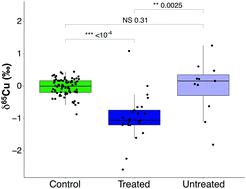当前位置:
X-MOL 学术
›
Metallomics
›
论文详情
Our official English website, www.x-mol.net, welcomes your
feedback! (Note: you will need to create a separate account there.)
The blood copper isotopic composition is a prognostic indicator of the hepatic injury in Wilson disease
Metallomics ( IF 2.9 ) Pub Date : 2020-09-17 , DOI: 10.1039/d0mt00167h Aline Lamboux 1 , Eduardo Couchonnal-Bedoya , Olivier Guillaud , Chloé Laurencin , Laurence Lion-François , Abdelouahed Belmalih , Elisabeth Mintz , Virginie Brun , Muriel Bost , Alain Lachaux , Vincent Balter
Metallomics ( IF 2.9 ) Pub Date : 2020-09-17 , DOI: 10.1039/d0mt00167h Aline Lamboux 1 , Eduardo Couchonnal-Bedoya , Olivier Guillaud , Chloé Laurencin , Laurence Lion-François , Abdelouahed Belmalih , Elisabeth Mintz , Virginie Brun , Muriel Bost , Alain Lachaux , Vincent Balter
Affiliation

|
Wilson disease (WD) is an autosomal recessive disorder of copper (Cu) metabolism. The gene responsible for WD, ATP7B, is involved in the cellular transport of Cu, and mutations in the ATP7B gene induce accumulation of Cu in the liver and ultimately in the brain. In a pilot study, the natural variations of copper stable isotope ratios (65Cu/63Cu) in the serum of WD patients have been shown to differ from that of healthy controls. In the present study, we challenged these first results by measuring the 65Cu/63Cu ratios in the blood of treated (n = 25), naïve patients (n = 11) and age matched healthy controls (n = 75). The results show that naïve patients and healthy controls exhibit undistinguishable 65Cu/63Cu ratios, implying that the Cu isotopic ratio cannot serve as a reliable diagnostic biomarker. The type of treatment (D-penicillamine vs. triethylenetetramine) does not affect the 65Cu/63Cu ratios in WD patients, which remain constant regardless of the type and duration of the treatment. In addition, the 65Cu/63Cu ratios do not vary in naïve patients after the onset of the treatment. However, the 65Cu/63Cu ratios decrease with the degree of liver fibrosis and the gradient of the phenotypic presentation, i.e. presymptomatic, hepatic and neurologic. To get insights into the mechanisms at work, we study the effects of the progress of the WD on the organism by measuring the Cu concentrations and the 65Cu/63Cu ratios in the liver, feces and plasma of 12 and 45 week old Atp7b−/− mice. The evolution of the 65Cu/63Cu ratios is marked by a decrease in all tissues. The results show that 63Cu accumulates in the liver preferentially to 65Cu due to the preferential cellular entry of 63Cu and the impairment of the 63Cu exit by ceruloplasmin. The hepatic accumulation of monovalent 63Cu+ is likely to fuel the production of free radicals, which is potentially an explanation of the pathogenicity of WD. Altogether, the results suggest that the blood 65Cu/63Cu ratio recapitulates WD progression and is a potential prognostic biomarker of WD.
中文翻译:

血铜同位素组成是威尔逊病肝损伤的预后指标
威尔逊病 (WD) 是一种铜 (Cu) 代谢的常染色体隐性遗传病。负责 WD 的基因ATP7B参与 Cu 的细胞转运,ATP7B基因的突变诱导 Cu 在肝脏中并最终在大脑中积累。在一项初步研究中,WD 患者血清中铜稳定同位素比率 ( 65 Cu/ 63 Cu)的自然变化已被证明与健康对照者不同。在本研究中,我们通过测量挑战这些第一结果65的Cu / 63在血液中的Cu比率的处理(Ñ = 25),初治患者(Ñ = 11)和年龄匹配的健康对照(Ñ= 75)。结果表明,初治患者和健康对照者表现出无法区分的65 Cu/ 63 Cu 比率,这意味着 Cu 同位素比率不能作为可靠的诊断生物标志物。治疗类型(D-青霉胺与三亚乙基四胺)不影响WD 患者的65 Cu/ 63 Cu 比率,无论治疗类型和持续时间如何,该比率都保持不变。此外,65 Cu/ 63 Cu 的比例在治疗开始后在初治患者中没有变化。然而,65 Cu/ 63Cu 比率随着肝纤维化的程度和表型呈现的梯度而降低,即症状前、肝脏和神经系统。为了深入了解工作机制,我们通过测量12 和 45 周龄Atp7b肝脏、粪便和血浆中的铜浓度和65 Cu/ 63 Cu 比率来研究 WD 进程对生物体的影响- /-老鼠。65 Cu/ 63 Cu 比率的演变以所有组织的减少为标志。结果表明,63铜在肝脏中积累优先,以65铜由于优先进入细胞63Cu 和铜蓝蛋白对63 Cu的损害。一价63 Cu +的肝脏积累可能会促进自由基的产生,这可能是 WD 致病性的一个解释。总而言之,结果表明血液65 Cu/ 63 Cu 比率概括了 WD 的进展,并且是 WD 的潜在预后生物标志物。
更新日期:2020-11-03
中文翻译:

血铜同位素组成是威尔逊病肝损伤的预后指标
威尔逊病 (WD) 是一种铜 (Cu) 代谢的常染色体隐性遗传病。负责 WD 的基因ATP7B参与 Cu 的细胞转运,ATP7B基因的突变诱导 Cu 在肝脏中并最终在大脑中积累。在一项初步研究中,WD 患者血清中铜稳定同位素比率 ( 65 Cu/ 63 Cu)的自然变化已被证明与健康对照者不同。在本研究中,我们通过测量挑战这些第一结果65的Cu / 63在血液中的Cu比率的处理(Ñ = 25),初治患者(Ñ = 11)和年龄匹配的健康对照(Ñ= 75)。结果表明,初治患者和健康对照者表现出无法区分的65 Cu/ 63 Cu 比率,这意味着 Cu 同位素比率不能作为可靠的诊断生物标志物。治疗类型(D-青霉胺与三亚乙基四胺)不影响WD 患者的65 Cu/ 63 Cu 比率,无论治疗类型和持续时间如何,该比率都保持不变。此外,65 Cu/ 63 Cu 的比例在治疗开始后在初治患者中没有变化。然而,65 Cu/ 63Cu 比率随着肝纤维化的程度和表型呈现的梯度而降低,即症状前、肝脏和神经系统。为了深入了解工作机制,我们通过测量12 和 45 周龄Atp7b肝脏、粪便和血浆中的铜浓度和65 Cu/ 63 Cu 比率来研究 WD 进程对生物体的影响- /-老鼠。65 Cu/ 63 Cu 比率的演变以所有组织的减少为标志。结果表明,63铜在肝脏中积累优先,以65铜由于优先进入细胞63Cu 和铜蓝蛋白对63 Cu的损害。一价63 Cu +的肝脏积累可能会促进自由基的产生,这可能是 WD 致病性的一个解释。总而言之,结果表明血液65 Cu/ 63 Cu 比率概括了 WD 的进展,并且是 WD 的潜在预后生物标志物。











































 京公网安备 11010802027423号
京公网安备 11010802027423号